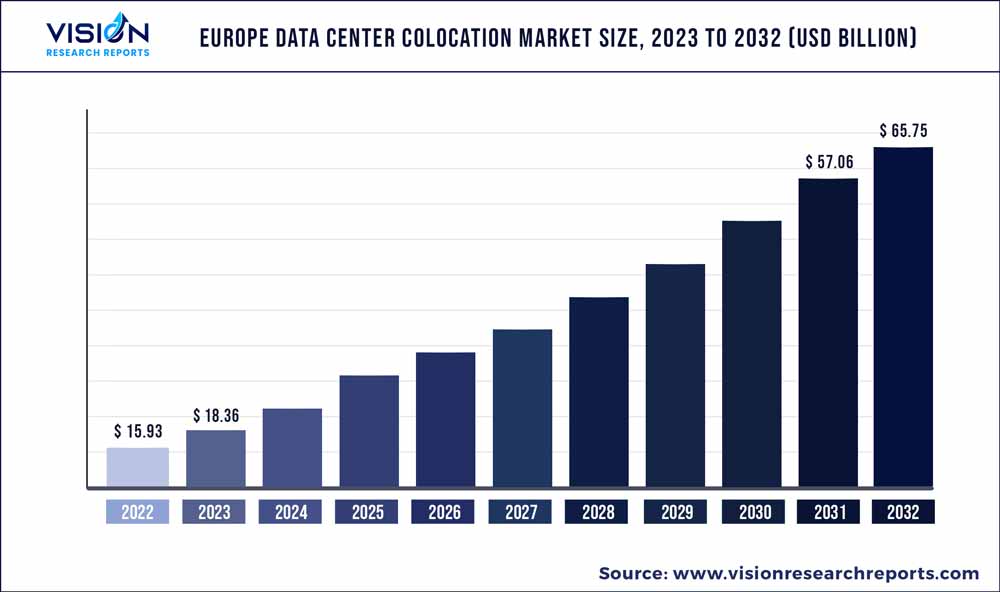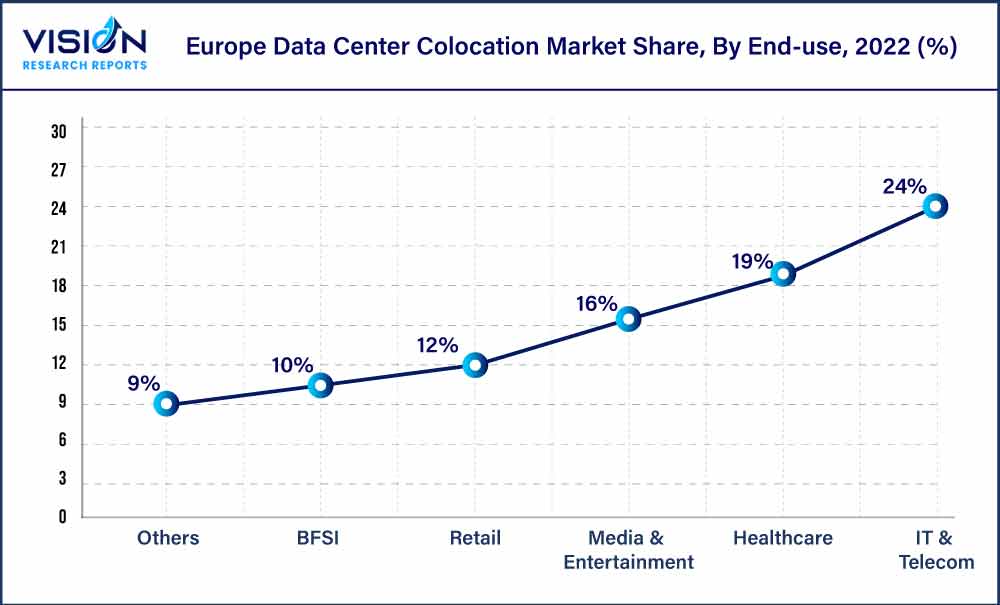The Europe data center colocation market was estimated at USD 15.93 billion in 2022 and it is expected to surpass around USD 65.75 billion by 2032, poised to grow at a CAGR of 15.23% from 2023 to 2032.

Key Pointers
Report Scope of the Europe Data Center Colocation Market
| Report Coverage | Details |
| Market Size in 2022 | USD 15.93 billion |
| Revenue Forecast by 2032 | USD 65.75 billion |
| Growth rate from 2023 to 2032 | CAGR of 15.23% |
| Base Year | 2022 |
| Forecast Period | 2023 to 2032 |
| Market Analysis (Terms Used) | Value (US$ Million/Billion) or (Volume/Units) |
| Companies Covered | CenturyLink; China Telecom Corporation Limited.; Colt Group Holdings Limited.; CoreSite Realty Corporation; CyrusOne; Cyxtera Technologies, Inc.; Digital Realty Trust, Inc.; Equinix, Inc.; Global Switch; Interxion; Iron Mountain Incorporated; NTT Communications Corporation; RACKSPACE TECHNOLOGY; Switch; Telehouse |
Major factors driving the growth of the Europe data center colocation industry include increasing demand for interconnection bandwidth and rising data traffic. With the emergence of edge computing applications, the need for high-capacity networks is growing considerably, and coping with the issues of network latency and the need for real-time insights led to the evolution of multi-locational hybrid data architectures, which has expanded the demand for transmission of data among private exchange points or data centers. Besides, businesses are shifting to the cloud, requiring higher bandwidth and enabling rapid, seamless data transfer and processing speeds.
The France, London, Amsterdam, Paris (FLAP) markets have dominated Europe's data center colocation for many years. These markets are still critical to the data center ecosystem from the market entry point of view. However, the FLAP markets have become mature and face limitations related to physical spaces and the need for more energy to power the data centers. Such constraints have propelled colocation providers to search for new locations such as Oslo, Berlin, Zurich, Reykjavik, Milan, Warsaw, Prague, and Vienna Madrid. These countries are regarded as potential hotspots for data center development across Europe.
Factors such as stringent environmental regulations in Europe and regional diversity are expected to challenge the market growth in the region. Colocation service providers may face contracting and multi-national product pricing complications with 23 languages spoken and 28 different currencies operating across Europe. Furthermore, such diversity increases data sovereignty issues across borders as GDPR has added liability and complexity to data management. However, companies can overcome these challenges by localizing their colocation services across European countries.
The high costs associated with owning and maintaining a data center, particularly for companies that generate inconsistent data volumes, are expected to be a key factor favoring market growth. Besides capital expenditure savings, data center colocation offers several other benefits to customers. Research studies suggest that owning or constructing a data center facility can cost over USD 300 per square foot, in addition to the cost incurred for laying the required fiber cabling. In such situations, in-house handling of an entire data center facility is a high-cost component for SMEs, whereas large-scale organizations can easily absorb this cost. Data center colocation is one solution that supports SMEs with a viable and affordable alternative to renting data center space, which is expected to drive market growth over the forecast period.
The market is driven by the significant demand for colocation services by hyperscale data center consumers such as public cloud service providers and large internet businesses. Besides setting up large data center campuses in remote areas, major cloud services providers such as Microsoft Azure, Google Cloud Platform, and Facebook has leased bunches of capacity from colocation data center companies in densely populated areas. The rise in colocation services results from increased network connectivity and the number of localized data centers in compliance with the General Data Protection Regulation (GDPR) to ensure data does not cross country borders. Europe is also witnessing increased demand from the Chinese telcos and hyper scalers looking to expand their global networks.
Type Insights
Regarding revenue, the retail colocation segment dominated the Europe market with a share of over 73% in 2022 and is estimated to retain the leading position throughout the forecast period. Small enterprises have limited data storage requirements, so they do not require dedicated data centers. As such, wholesale colocation services are expensive for small businesses as they only offer space and power, whereas the enterprises themselves must manage the IT infrastructure and staffing. Retail colocation provides racks, private data center suites, cabinets, and staffing suitable for small enterprises for a limited time.
Wholesale colocation data centers are still preferred among large businesses as they offer large space, which can accommodate large data volume configurations. The implementation of GDPR has led to increased investments in the wholesale colocation space by major cloud service providers. These investments result from customers becoming critical of their data storage while closely monitoring the data storage methods. As such, wholesale colocation allows cloud service providers to localize their large data centers while complying with GDPR and gaining customer trust.
Enterprise Size Insights
The large enterprise segment accounted for the largest revenue share of over 61% in 2022. This is attributed to major cloud service providers and hyper scalers adopting colocation services. Large enterprises manage a large volume of data and require infrastructure with high capacities and ample floor space to accommodate the equipment. Datacenter colocation helps these enterprises to fulfill their power and space requirements with complete control over data center infrastructure. These factors have resulted in large enterprises shifting toward colocation services rather than building and operating their own data centers.
The rising number of startup businesses has fueled the demand for colocation data centers across Europe. SMEs cannot afford to build and operate data centers, so they depend on colocation data centers. Meanwhile, small enterprises do not require the set-up of extensive data center facilities. Therefore, several SMEs find it suitable to deploy colocation centers and save on fixed, operational, and maintenance costs, subsequently driving market growth.
End-use Insights
The healthcare segment is expected to record the highest growth rate of over 19% over the forecast period in the market. The growth of colocation data centers in the healthcare industry can be attributed to the benefits such as shifting infrastructure from on-premise to off-premise, redundancy of colocation networks offering high uptime records, lower OPEX, and better resource allocation, diverse connectivity options, enhanced security compliance enabling reduced risk among others. Moreover, major companies in the regional market offer healthcare solutions, such as CoreSite Realty Corporation, Digital Realty Trust, Inc., and Iron Mountain Incorporated, among others, have also been crucial in developing the healthcare segment. The benefits of opting for colocation data centers by the healthcare industry, along with the availability of colocation data centers of top companies in the market, have contributed to the growth of the healthcare segment in the region’s data center colocation market over the forecast period.

The IT and telecom segment dominates the market presently with the largest market share and is expected to continue its dominance over the forecast period. The large market share is due to the continuous development of software and application in the industry and the launch of several start-ups across the region. Meanwhile, the telecom sector has witnessed a surge in mobile internet users, which has created a massive demand for data storage in the past years. The advancement in technologies such as IoT and 5G is expected to drive growth in the IT and telecom industry, driving market growth in the forthcoming years.
Europe Data Center Colocation Market Segmentations:
By Type
By Enterprise Size
By End-Use
Chapter 1. Introduction
1.1. Research Objective
1.2. Scope of the Study
1.3. Definition
Chapter 2. Research Methodology
2.1. Research Approach
2.2. Data Sources
2.3. Assumptions & Limitations
Chapter 3. Executive Summary
3.1. Market Snapshot
Chapter 4. Market Variables and Scope
4.1. Introduction
4.2. Market Classification and Scope
4.3. Industry Value Chain Analysis
4.3.1. Raw Material Procurement Analysis
4.3.2. Sales and Distribution Type Analysis
4.3.3. Downstream Buyer Analysis
Chapter 5. COVID 19 Impact on Europe Data Center Colocation Market
5.1. COVID-19 Landscape: Europe Data Center Colocation Industry Impact
5.2. COVID 19 - Impact Assessment for the Industry
5.3. COVID 19 Impact: Major Government Policy
5.4. Market Trends and Opportunities in the COVID-19 Landscape
Chapter 6. Market Dynamics Analysis and Trends
6.1. Market Dynamics
6.1.1. Market Drivers
6.1.2. Market Restraints
6.1.3. Market Opportunities
6.2. Porter’s Five Forces Analysis
6.2.1. Bargaining power of suppliers
6.2.2. Bargaining power of buyers
6.2.3. Threat of substitute
6.2.4. Threat of new entrants
6.2.5. Degree of competition
Chapter 7. Competitive Landscape
7.1.1. Company Market Share/Positioning Analysis
7.1.2. Key Strategies Adopted by Players
7.1.3. Vendor Landscape
7.1.3.1. List of Suppliers
7.1.3.2. List of Buyers
Chapter 8. Europe Data Center Colocation Market, By Type
8.1. Europe Data Center Colocation Market, by Type, 2023-2032
8.1.1 Retail Colocation
8.1.1.1. Market Revenue and Forecast (2020-2032)
8.1.2. Wholesale Colocation
8.1.2.1. Market Revenue and Forecast (2020-2032)
Chapter 9. Europe Data Center Colocation Market, By Enterprise Size
9.1. Europe Data Center Colocation Market, by Enterprise Size, 2023-2032
9.1.1. SMEs
9.1.1.1. Market Revenue and Forecast (2020-2032)
9.1.2. Large Enterprises
9.1.2.1. Market Revenue and Forecast (2020-2032)
Chapter 10. Europe Data Center Colocation Market, By End-Use
10.1. Europe Data Center Colocation Market, by End-Use, 2023-2032
10.1.1. BFSI
10.1.1.1. Market Revenue and Forecast (2020-2032)
10.1.2. Healthcare
10.1.2.1. Market Revenue and Forecast (2020-2032)
10.1.3. IT & Telecom
10.1.3.1. Market Revenue and Forecast (2020-2032)
10.1.4. Media & Entertainment
10.1.4.1. Market Revenue and Forecast (2020-2032)
10.1.5. Retail
10.1.5.1. Market Revenue and Forecast (2020-2032)
10.1.6. Others
10.1.6.1. Market Revenue and Forecast (2020-2032)
Chapter 11. Europe Data Center Colocation Market, Regional Estimates and Trend Forecast
11.1. Europe
11.1.1. Market Revenue and Forecast, by Type (2020-2032)
11.1.2. Market Revenue and Forecast, by Enterprise Size (2020-2032)
11.1.3. Market Revenue and Forecast, by End-Use (2020-2032)
Chapter 12. Company Profiles
12.1. CenturyLink
12.1.1. Company Overview
12.1.2. Product Offerings
12.1.3. Financial Performance
12.1.4. Recent Initiatives
12.2. China Telecom Corporation Limited..
12.2.1. Company Overview
12.2.2. Product Offerings
12.2.3. Financial Performance
12.2.4. Recent Initiatives
12.3. Colt Group Holdings Limited..
12.3.1. Company Overview
12.3.2. Product Offerings
12.3.3. Financial Performance
12.3.4. Recent Initiatives
12.4. CoreSite Realty Corporation.
12.4.1. Company Overview
12.4.2. Product Offerings
12.4.3. Financial Performance
12.4.4. Recent Initiatives
12.5. CyrusOne
12.5.1. Company Overview
12.5.2. Product Offerings
12.5.3. Financial Performance
12.5.4. Recent Initiatives
12.6. Cyxtera Technologies, Inc.
12.6.1. Company Overview
12.6.2. Product Offerings
12.6.3. Financial Performance
12.6.4. Recent Initiatives
12.7. Digital Realty Trust, Inc..
12.7.1. Company Overview
12.7.2. Product Offerings
12.7.3. Financial Performance
12.7.4. Recent Initiatives
12.8. Equinix, Inc.
12.8.1. Company Overview
12.8.2. Product Offerings
12.8.3. Financial Performance
12.8.4. Recent Initiatives
12.9. Switch.
12.9.1. Company Overview
12.9.2. Product Offerings
12.9.3. Financial Performance
12.9.4. Recent Initiatives
12.10. Interxion
12.10.1. Company Overview
12.10.2. Product Offerings
12.10.3. Financial Performance
12.10.4. Recent Initiatives
Chapter 13. Research Methodology
13.1. Primary Research
13.2. Secondary Research
13.3. Assumptions
Chapter 14. Appendix
14.1. About Us
14.2. Glossary of Terms
 Cross-segment Market Size and Analysis for
Mentioned Segments
Cross-segment Market Size and Analysis for
Mentioned Segments
 Additional Company Profiles (Upto 5 With No Cost)
Additional Company Profiles (Upto 5 With No Cost)
 Additional Countries (Apart From Mentioned Countries)
Additional Countries (Apart From Mentioned Countries)
 Country/Region-specific Report
Country/Region-specific Report
 Go To Market Strategy
Go To Market Strategy
 Region Specific Market Dynamics
Region Specific Market Dynamics Region Level Market Share
Region Level Market Share Import Export Analysis
Import Export Analysis Production Analysis
Production Analysis Others
Others